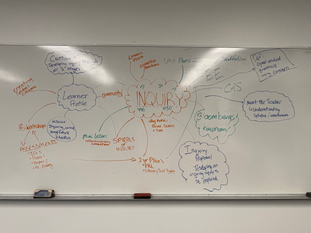Katie's Korner


My pedagogical stance has been deeply influenced by transformative educational experiences rooted in critical pedagogy, equity-focused teaching, and a student-centred approach incorporating experiential and inclusive education. These experiences have led me to value certain aspects of the systems I’ve been a part of. I also recognize the need to challenge and transform the parts that perpetuate inequity. This journey has instilled in me a sense of hope and inspiration for the future of education.
I’m deeply aware of how Western, neoliberal, and colonial influences shaped my education. Growing up in a private school with an IB curriculum, I benefited from a system that prioritized academic rigour but failed to include Indigenous voices or perspectives. It’s clear to me now that this exclusion isn’t just a flaw but a systemic issue perpetuating cultural erasure. As someone who is white-presenting, I recognize the privilege that allowed me to navigate this system with relative ease. I feel a responsibility to use that privilege to advocate for more inclusive practices that honour diverse ways of knowing and learning.
My commitment to breaking down barriers in education is unwavering. I’ve witnessed firsthand how socioeconomic barriers, like the paywalls of private education and the IB program, create inequities that prevent many students from accessing the same opportunities I had. As a future educator, I’m dedicated to creating learning environments where these barriers are dismantled, and all students can thrive, regardless of their background. This dedication should reassure you of my commitment to inclusive education.
One of the most impactful parts of my educational journey was my year at an environmental school. This experience taught me the value of experiential and place-based learning, where the local environment and hands-on experiences were at the heart of education. It mirrored Indigenous pedagogical principles, such as connecting to the land and learning through experience. While I struggled with the lack of structure at the time, I now see how transformative this approach can be. It gave me a deeper understanding of how education can look beyond the classroom and how meaningful connections to the land and the learning process can foster responsibility and care.
At the same time, I’ve also experienced the pressures and pitfalls of Westernized education. My upbringing in an academically rigorous and structured environment fostered my love of learning and ingrained in me a fear of failure and an obsession with perfection. Looking back, I can see how standardized testing and the constant need to measure success positively and negatively shaped me. As I prepare to become an educator, I’m determined to create a classroom where learning isn’t driven by fear or external validation but by curiosity, joy, and growth.
The teacher I aspire to be prioritizes relationships, curiosity, and lifelong learning. I want my students to feel excited to step into my classroom, knowing they’re entering a space where they’ll be encouraged to ask questions, make connections, and discover their potential. To me, being an educator means being a lifelong learner who grows alongside my students, always looking for ways to make education more meaningful and inclusive.
My ultimate goal is to balance structure and flexibility, providing the tools and guidance my students need to succeed while allowing them the freedom to explore, question, and make mistakes. I want to create an environment where every student can feel seen, supported, and inspired, no matter their background or learning style. Above all, education should be joyful, transformative, and empowering—not just for the students but for me as an educator. If I approach teaching with this mindset, I believe we can all grow beyond what the system tells us we’re capable of.




